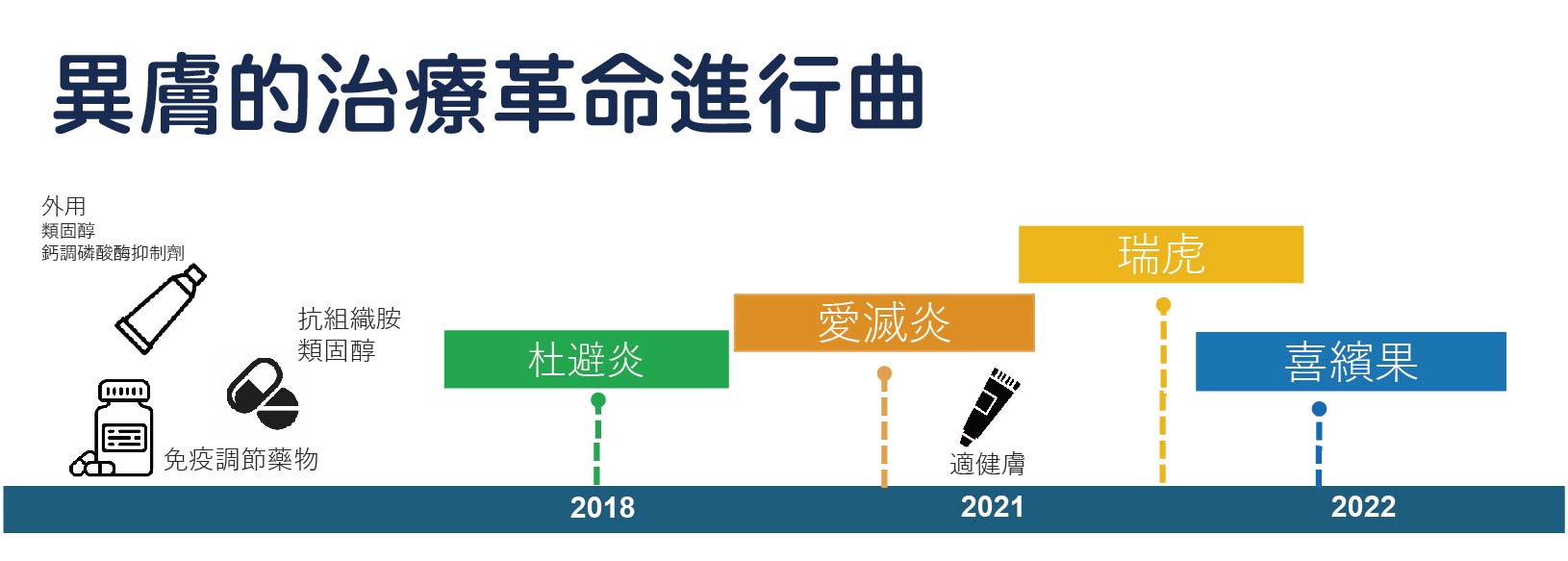Revolutionary March of Atopic Dermatitis Treatment
Update Date:2025/03/05,
Views:34
Dr. Chen Yi-Hsien, Dermatology Department
Atopic dermatitis (eczema) is a chronic, relapsing inflammatory skin condition characterized by dry, inflamed, and itchy rashes. The cause of the disease is believed to be related to genetic factors, abnormal immune activation, and environmental triggers. While it is not a life-threatening condition, the prolonged course and recurrent nature of the disease significantly impact the patient's physical, mental, and social well-being.
Challenges of Traditional Treatment Approaches
Traditional treatments primarily focus on symptom relief and include topical medications such as steroids, calcineurin inhibitors, and oral corticosteroids or antihistamines. For moderate to severe cases, phototherapy or traditional immunomodulatory drugs like Methotrexate, Cyclosporine, and newer biologics are also used. However, these treatments may be ineffective because they do not address the underlying mechanisms of the disease. Additionally, due to individual differences among patients, side effects may occur, or the treatments may lack convenience. As a result, they often fail to meet the needs of moderate to severe patients, particularly when the condition relapses or when the medications lose their effectiveness, leading to a greater disease burden for the patient.
Latest Biologic Therapies
With recent advances in the understanding of the pathophysiology of atopic dermatitis (AD), scientists have identified key immune pathways, such as IL-4 and IL-13, which provide new directions for treatment development. By inhibiting specific cytokines, biologic therapies have brought significant breakthroughs in the treatment of AD.
Dupixent (dupilumab) was the first biologic therapy approved for the treatment of AD. It works by blocking IL-4 and IL-13 signaling pathways. Clinical trials have shown that patients receiving this treatment experienced a significant reduction in itching and lesion area, along with a notable improvement in quality of life. Due to its favorable safety profile, it has become an important treatment option for patients with moderate-to-severe AD.
A newly launched biologic, Ebglyss (lebrikizumab), specifically targets and blocks the IL-13 signaling pathway. Like Dupixent, it has demonstrated promising therapeutic effects, making it a strong contender in the field of AD treatment.
Application of Small Molecule Drugs
In addition to biologic therapies, research on small molecule drugs has also made remarkable progress. Janus kinase (JAK) inhibitors represent a novel oral treatment approach that reduces the expression of inflammation-related genes by inhibiting JAK signaling pathways. JAK inhibitors such as Olumiant (baricitinib), Cibinqo (abrocitinib), and Rinvoq (upadacitinib) have demonstrated excellent efficacy in clinical trials. These medications not only provide rapid itch relief and significant lesion clearance but also offer patients a convenient treatment option.
Adjunctive Role of Non-Pharmacological Therapies
Beyond pharmacological treatments, lifestyle modifications and non-drug therapies are equally important in managing atopic dermatitis (AD). Key strategies include the regular use of moisturizers, avoiding allergenic irritants, and minimizing stress. These measures help alleviate symptoms and reduce the frequency and severity of flare-ups.
Future Prospects for Personalized Treatment
With advancements in genetic technology and precision medicine, personalized treatment may soon become a new trend in AD management. By analyzing a patient’s genetic profile, immune status, and disease progression, physicians can tailor the most suitable treatment plan, enhancing efficacy while minimizing side effects. For example, certain patients may respond better to specific biologics or JAK inhibitors, while others may benefit from a combination of traditional therapies.
Conclusion
The field of AD treatment is undergoing an unprecedented transformation. The emergence of biologics and small molecule drugs has provided new hope for patients. While challenges such as high treatment costs and long-term safety concerns remain, ongoing technological advancements are expected to make AD treatments more effective, safer, and more accessible in the future.
